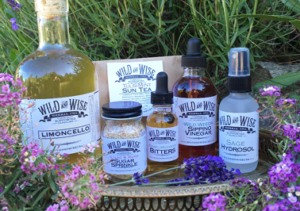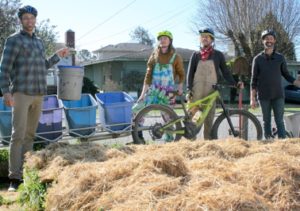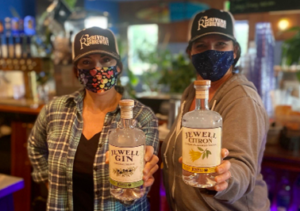
Nue-ne-pueh Mehl Kee Tey-nem’mo-nee ‘Oohl
(Comida para el pueblo)
de Taylor Thompson | fotografías de Louisa McCovey

Cocción de salmón al estilo tradicional en palitos de secuoya / crédito de la foto: Louisa McCovey
El pueblo Yurok ha permanecido existiendo sobre la parte inferior del río Klamath y las aldeas que se encuentran a lo largo de la costa del Pacífico desde Noohl Hee-Kon (tiempo inmemorable). La tribu Yurok es la tribu indígena mas grande de California reconocida a nivel federal, con más de 6.290 miembros. La gente del pueblo Yurok continúa residiendo en aldeas y comunidades a lo largo del Territorio Ancestral, incluidas algunas partes de los condados del Norte y Humboldt, y se extiende mucho más allá de los límites actuales de la Reserva India Yurok.
El borde costero del Territorio Ancestral Yurok se extiende desde la cuenca de drenaje del río Little en su frontera sur, incluyendo Trinidad y Orick, hasta Damnation Creek en el norte. El territorio se extiende a lo largo del río Klamath a través de la cuenca de drenaje de Bluff Creek, incluye una parte del río Trinity y secciones del Parque Nacional y Estatal Redwood y el Bosque Nacional Six Rivers.
Hoy en día, la Reserva India Yurok forma parte de tierras a una milla por cada lado de las 46 millas del río Klamat, justo por encima de la confluencia del río Trinity en Weitchpec hasta la desembocadura del río en el Océano Pacífico, abarcando más de 55,000 hectáreas.
La gente de Yurok es conocida como buenos pescadores, cazadores, tejedores de cestas, fabricantes de canoas, narradores de historias, cantantes, bailarines, curanderos y persona medicina . La gente del pueblo Yurok siempre ha confiado en las múltiples ofertas alimenticias que ofrece el río Klamath, la costa del Pacífico y algunas áreas de su interior. Algunos ejemplos incluyen ney-puy (salmón), kaa-ka (esturión), kwor-ror (pez vela), pee-ee (mejillones), chey-gel ‘(algas), woo-mehl (bellotas), puuek (ciervos) , mey-weehl (alce), ley-chehl (bayas) y wey-yok-seep (tés).
Desde la llegada de los Europeos Americanos, en el pueblo Yurok su sistema alimentario tradicionales se han resentido. Los efectos del intento de genocidio, el cambio climático global, los sistemas agrícolas suplantados, y las prácticas tradicionales de gestión de la tierra fuera de regulación, la sobrepesca por parte de colonos no indígenas, la mala gestión de la naturaleza, la construcción de represas en canales fluviales y muchos otros problemas están teniendo efectos reales en la capacidad del pueblo Yurok para acceder a sus alimentos tradicionales. El USDA ha declarado la Reserva India Yurok como un desierto alimenticio, los residentes del pueblo tienen que conducir más de una hora para llegar al supermercado más cercano. Aquellos que no tienen un vehículo, tienen que buscar alguien que les haga las compras, dependen del sistema de transporte público local, a menudo impredecible, donde el viaje puede tomar un día entero.
Uno de los muchos enfoques para restaurar el acceso a los alimentos tradicionales es abordar la inseguridad alimentaria dentro de la Reserva, la Tribu Yurok creó la División de Soberanía Alimentaria, una subsección del Programa Ambiental de la Tribu Yurok. Aunque la División de Soberanía Alimentaria había estado en desarrollo durante un tiempo, en el momento de la pandemia de COVID-19, se expuso la fragilidad de los sistemas alimentarios, fueron aún mas claras las necesidad de un programa de alimentos centralizado dentro de la Tribu Yurok. Fundada oficialmente en agosto de 2020, la División de Soberanía Alimentaria ha establecido un objetivo general de lograr la soberanía alimentaria de la tribu Yurok. Para esta meta, la soberanía alimentaria del pueblo Yurok tienen necesidades alimentarias, tanto en el sentido nutricional como cultural, satisfacer a un nivel en el que se pueda prosperar sin depender de sistemas alimentarios externos.
Para restaurar la soberanía alimentaria en su totalidad de la tribu Yurok, la División de la Soberanía Alimentaria está trabajando para crear un sistema alimentario holístico mediante el desarrollo de aldeas alimentarias, llamadas Nue-ne-pueh Mehl Kee Tey-nem’mo-nee ‘Oohl (Alimentos para el Personas), en toda la Reserva y eventualmente en todo el Territorio Ancestral. Completamente actualizado, cada Nue-ne-pueh Mehl Kee Tey-nem’mo-nee ‘Oohl incluirá un edificio inspirado en las casas tradicionales del pueblo Yurok que proporcionará a la comunidad local y a los empleados de Soberanía Alimentaria un espacio para la enseñanza y el aprendizaje, preservación, procesamiento y técnicas de cocción para alimentos tradicionales. Tendrán espacios en jardínes, invernaderos y estructuras que permitirán que los miembros de la comunidad aprendan sobre la producción de alimentos en el lugar. Nue-ne-pueh Mehl Kee Tey-nem’mo-nee ‘Oohl incorporará agricultura regenerativa, energías renovables y prácticas tradicionales de gestión de la tierra Yurok, incluidos la tradicional roza y quema.
Aunque hay mucho más trabajo por hacer para crear los primeros tres Nue-ne-pueh Mehl Kee Tey-nem’mo-nee ‘Oohl dentro de la Reserva, el proyecto ha recibido un respaldo significativo de la comunidad, el Consejo Tribal Yurok y fundadoreres de las regiones circundantes para comenzar el desarrollo del proyecto.
La tribu Yurok recientemente compró una propiedad adyacente a la escuela primaria en Klamath que será el sitio de Nue-ne-pueh Mehl Kee Tey-nem’mo-nee ‘Oohl para esa comunidad. Se ha obtenido financiamiento externo para el personal que trabajará ahí y para comenzar a crear su espacio de producción de alimentos; el componente del jardín se llamará “O goo-hehl (jardín).
Aunque las asociaciones actuales con otros grupos centrados en programas alimentarios comunitarios ayudarán a desarrollar los componentes de producción de alimentos de los tres sitios planificados, existe la necesidad de apoyo adicionales, ya que el objetivo de la soberanía alimentaria requerirá esfuerzos significativos alrededor de la producción, procesamiento y distribución de alimentos. .
Más allá de establecer y expandir la producción de alimentos en los tres sitios Nue-ne-pueh Mehl Kee Tey-nem’mo-nee ‘Oohl, la División de Soberanía Alimentaria está trabajando para obtener fondos para la creación de estos edificios centralizados de forma tradicional. Los edificios permitirán la expansión de nuestra capacidad educativa actual, de la granja a la escuela y brindarán espacio para que la gente del pueblo Yurok aprenda la producción, conservación, procesamiento y cómo cocinar los alimentos tradicionales y contemporáneos, que ayudarán a fomentar la comunicación de conocimientos y tradiciones que han existido por generaciones y que aumentarán la capacidad de la Tribu para autosustentarse.

Sopa de bellotas preparada tradicionalmente; cesta y cuchara hechos por Deborah McConnell / crédito de la foto: Louisa McCovey
. . . . . . . . . . . . . . . . . . . . . . . . . . . . . . . . . . .
Taylor Thompson (el) Gerente de la División de Soberanía Alimentaria del Programa Ambiental de la Tribu Yurok.
. . . . . . . . . . . . . . . . . . . . . . . . . . . . . . . . . . .
Louisa McCovey (ella) es la Directora del Programa Ambiental de la Tribu Yurok.
. . . . . . . . . . . . . . . . . . . . . . . . . . . . . . . . . . .





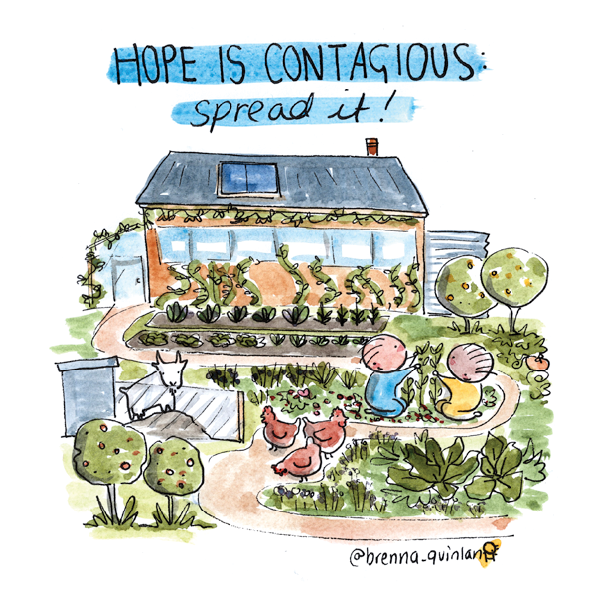


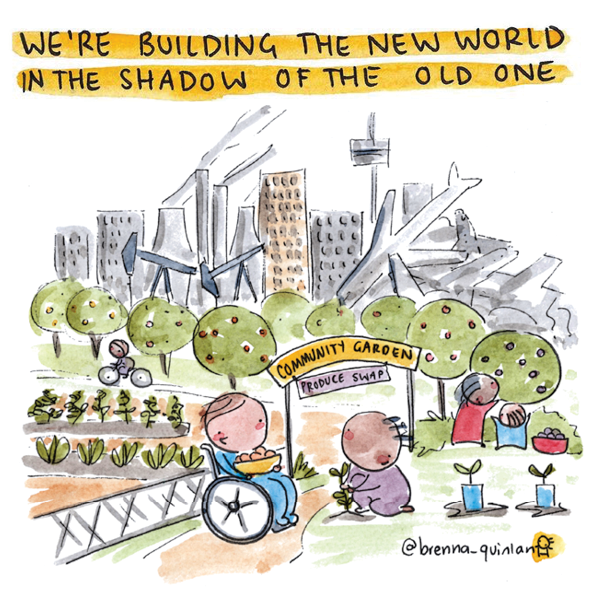 GROW KNOWLEDGE & ANTI-RACIST PRACTICES
GROW KNOWLEDGE & ANTI-RACIST PRACTICES SUPPORT COMMUNITY-RUN COLLECTIVES
SUPPORT COMMUNITY-RUN COLLECTIVES







